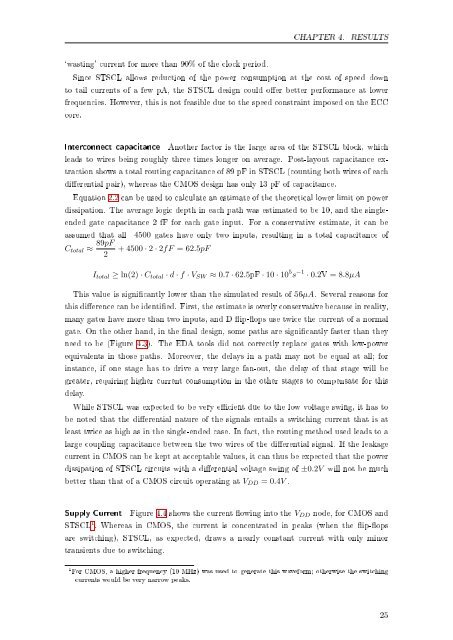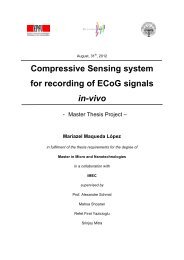Ultra-Low-Power Digital Circuit Design - Microelectronic Systems ...
Ultra-Low-Power Digital Circuit Design - Microelectronic Systems ...
Ultra-Low-Power Digital Circuit Design - Microelectronic Systems ...
- No tags were found...
Create successful ePaper yourself
Turn your PDF publications into a flip-book with our unique Google optimized e-Paper software.
CHAPTER 4.RESULTS`wasting' current for more than 90% of the clock period.Since STSCL allows reduction of the power consumption at the cost of speed downto tail currents of a few pA, the STSCL design could oer better performance at lowerfrequencies. However, this is not feasible due to the speed constraint imposed on the ECCcore.Interconnect capacitanceAnother factor is the large area of the STSCL block, whichleads to wires being roughly three times longer on average. Post-layout capacitance extractionshows a total routing capacitance of 89 pF in STSCL (counting both wires of eachdierential pair), whereas the CMOS design has only 13 pF of capacitance.Equation 2.2 can be used to calculate an estimate of the theoretical lower limit on powerdissipation. The average logic depth in each path was estimated to be 10, and the singleendedgate capacitance 2 fF for each gate input. For a conservative estimate, it can beassumed that all 4500 gates have only two inputs, resulting in a total capacitance ofC total ≈ 89pF + 4500 · 2 · 2fF = 62.5pF2I total ≥ ln(2) · C total · d · f · V SW ≈ 0.7 · 62.5pF · 10 · 10 5 s −1 · 0.2V = 8.8µAThis value is signicantly lower than the simulated result of 56µA. Several reasons forthis dierence can be identied. First, the estimate is overly conservative because in reality,many gates have more than two inputs, and D ip-ops use twice the current of a normalgate. On the other hand, in the nal design, some paths are signicantly faster than theyneed to be (Figure 4.3). The EDA tools did not correctly replace gates with low-powerequivalents in those paths. Moreover, the delays in a path may not be equal at all; forinstance, if one stage has to drive a very large fan-out, the delay of that stage will begreater, requiring higher current consumption in the other stages to compensate for thisdelay.While STSCL was expected to be very ecient due to the low voltage swing, it has tobe noted that the dierential nature of the signals entails a switching current that is atleast twice as high as in the single-ended case. In fact, the routing method used leads to alarge coupling capacitance between the two wires of the dierential signal. If the leakagecurrent in CMOS can be kept at acceptable values, it can thus be expected that the powerdissipation of STSCL circuits with a dierential voltage swing of ±0.2V will not be muchbetter than that of a CMOS circuit operating at V DD = 0.4V .Supply Current Figure 4.4 shows the current owing into the V DD node, for CMOS andSTSCL 1 . Whereas in CMOS, the current is concentrated in peaks (when the ip-opsare switching), STSCL, as expected, draws a nearly constant current with only minortransients due to switching.1 For CMOS, a higher frequency (10 MHz) was used to generate this waveform; otherwise the switchingcurrents would be very narrow peaks.25















